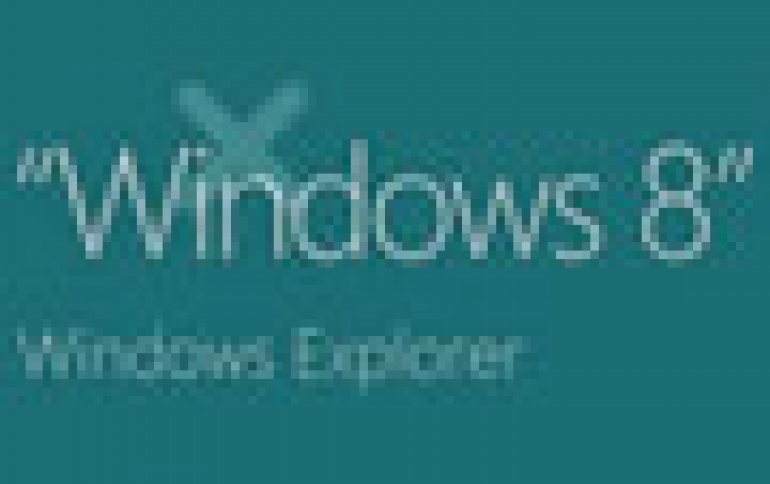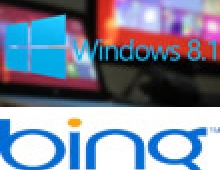
Windows 8 To Offer Easier And Faster Recovering Options
Windows 8 will offer two options to provide a way for
users to restore the operating system to a clean state
- reset and refresh.
The "Reset" feature will remove all personal data,
apps, and settings from the PC, and will reinstall
Windows. The "Refresh" option will Keep all personal
data, Metro style apps, and important settings from the
PC, and will reinstall Windows.
Resetting your Windows 8 PC goes like this:
- The PC boots into the Windows Recovery Environment (Windows RE).
- Windows RE erases and formats the hard drive partitions on which Windows and personal data reside.
- Windows RE installs a fresh copy of Windows.
- The PC restarts into the newly installed copy of Windows.
For those of you who worry about data that may still be recoverable after a standard reset, especially on PCs with sensitive personal data, Microsoft will be providing an option in Windows 8 Beta to erase your data more thoroughly, with additional steps that can limit the effectiveness of even sophisticated data recovery attempts. Instead of just formatting the drive, choosing the "Thorough" option will write random patterns to every sector of the drive, overwriting any existing data visible to the operating system.
According to Microsoft, resetting the PC (quick) will take 6 minutes 12 seconds. A thorough reset with BitLocker enabled will take approximately 6 minutes 21 seconds. Finally, resetting the PC thorough, without BitLocker will take you 23 minutes 52 seconds.
Resetting your PC can take you back to square one if you encounter a problem, but that?s clearly a very heavy weight solution. But what if you could get the benefit of a reset ? starting over with a fresh Windows install ? while still keeping your stuff intact? This is where Refresh comes in handy. Refresh functionality is fundamentally still a reinstall of Windows, just like resetting your PC as described above, but your data, settings, and Metro style apps are preserved.
The coolest part about Refresh is there?s no need to first back up your data to an external hard drive and restore them afterwards.
Refreshing your PC goes like this:
- The PC boots into Windows RE.
- Windows RE scans the hard drive for your data, settings, and apps, and puts them aside (on the same drive).
- Windows RE installs a fresh copy of Windows.
- Windows RE restores the data, settings, and apps it has set aside into the newly installed copy of Windows.
- The PC restarts into the newly installed copy of Windows.
According to Microsoft, refreshing your PC will take approximately 8 minutes 22 seconds.
Unlike manually reinstalling Windows, you don't have to go through the Windows Welcome screens again and reconfigure all the initial settings, as your user accounts and those settings are all preserved. You can sign in with the same account and password, and all of your documents and data are preserved in the same locations they were before. To accomplish this, Microsoft actually used the same imaging and migration technologies behind Windows Setup.
To ensure that Refresh is both effective in fixing problems and in making sure users don't lose settings that they might have trouble reconfiguring, Microsoft has thought a great deal about which settings to preserve. In Windows 8 Beta, some of the settings Microsoft will preserve include:
- Wireless network connections
- Mobile broadband connections - BitLocker and BitLocker To Go settings
- Drive letter assignments
- Personalization settings such as lock screen
background and desktop wallpaper
On the other hand, Microsoft deliberately chose not to preserve the following settings, as they can occasionally cause problems if misconfigured:
- File type associations
- Display settings
- Windows Firewall settings
In the Refresh option only Metro style apps are preserved, and require desktop apps that do not come with the PC to be reinstalled manually. Microsoft does this for two reasons. First, in many cases there is a single desktop app that is causing the problems that lead to a need to perform this sort of maintenance, but identifying this root cause is not usually possible. And second, it will prevent users from inadvertently reinstall "bad" apps that were installed unintentionally.
You can, however, cleanly install and uninstall all Metro style apps using the .appx package format. If you do need to reinstall some desktop apps after you refresh your PC, Microsoft saves the list of apps that were not preserved in an HTML file, and put this list on the desktop, so you have a quick way to see what you might need to reinstall and where to find them.
One caution is that if any desktop apps you have require a license key, you will need to follow your manufacturer's instructions for how to reuse the key. This might involve uninstalling the app first, going to a web site, or going through some automated steps by phone, for example.
In Windows 8 Beta, there will also be a tool that you can use to create a bootable USB flash drive, in case even the copy of Windows RE on the hard drive won't start. You'll be able to start your PC with the USB drive, and fix problems by refreshing your PC or performing advanced troubleshooting. And if your PC comes with a hidden recovery partition, you'll even have the option to remove it and reclaim disk space once you've created the USB drive.
You will be also able to establish their own baseline OS image via a command-line tool (recimg.exe). After you've created the custom image, whenever you refresh your PC, not only will you be able to keep your personal data, settings, and Metro style apps, but you can restore all the desktop apps in your custom image as well. And if you buy a PC that already comes with a recovery image on a hidden partition, you'll be able to use the tool to switch from using the hidden partition to instead use the custom image you?ve created.
Resetting your Windows 8 PC goes like this:
- The PC boots into the Windows Recovery Environment (Windows RE).
- Windows RE erases and formats the hard drive partitions on which Windows and personal data reside.
- Windows RE installs a fresh copy of Windows.
- The PC restarts into the newly installed copy of Windows.
For those of you who worry about data that may still be recoverable after a standard reset, especially on PCs with sensitive personal data, Microsoft will be providing an option in Windows 8 Beta to erase your data more thoroughly, with additional steps that can limit the effectiveness of even sophisticated data recovery attempts. Instead of just formatting the drive, choosing the "Thorough" option will write random patterns to every sector of the drive, overwriting any existing data visible to the operating system.
According to Microsoft, resetting the PC (quick) will take 6 minutes 12 seconds. A thorough reset with BitLocker enabled will take approximately 6 minutes 21 seconds. Finally, resetting the PC thorough, without BitLocker will take you 23 minutes 52 seconds.
Resetting your PC can take you back to square one if you encounter a problem, but that?s clearly a very heavy weight solution. But what if you could get the benefit of a reset ? starting over with a fresh Windows install ? while still keeping your stuff intact? This is where Refresh comes in handy. Refresh functionality is fundamentally still a reinstall of Windows, just like resetting your PC as described above, but your data, settings, and Metro style apps are preserved.
The coolest part about Refresh is there?s no need to first back up your data to an external hard drive and restore them afterwards.
Refreshing your PC goes like this:
- The PC boots into Windows RE.
- Windows RE scans the hard drive for your data, settings, and apps, and puts them aside (on the same drive).
- Windows RE installs a fresh copy of Windows.
- Windows RE restores the data, settings, and apps it has set aside into the newly installed copy of Windows.
- The PC restarts into the newly installed copy of Windows.
According to Microsoft, refreshing your PC will take approximately 8 minutes 22 seconds.
Unlike manually reinstalling Windows, you don't have to go through the Windows Welcome screens again and reconfigure all the initial settings, as your user accounts and those settings are all preserved. You can sign in with the same account and password, and all of your documents and data are preserved in the same locations they were before. To accomplish this, Microsoft actually used the same imaging and migration technologies behind Windows Setup.
To ensure that Refresh is both effective in fixing problems and in making sure users don't lose settings that they might have trouble reconfiguring, Microsoft has thought a great deal about which settings to preserve. In Windows 8 Beta, some of the settings Microsoft will preserve include:
- Wireless network connections
- Mobile broadband connections - BitLocker and BitLocker To Go settings
- Drive letter assignments
- Personalization settings such as lock screen
background and desktop wallpaper
On the other hand, Microsoft deliberately chose not to preserve the following settings, as they can occasionally cause problems if misconfigured:
- File type associations
- Display settings
- Windows Firewall settings
In the Refresh option only Metro style apps are preserved, and require desktop apps that do not come with the PC to be reinstalled manually. Microsoft does this for two reasons. First, in many cases there is a single desktop app that is causing the problems that lead to a need to perform this sort of maintenance, but identifying this root cause is not usually possible. And second, it will prevent users from inadvertently reinstall "bad" apps that were installed unintentionally.
You can, however, cleanly install and uninstall all Metro style apps using the .appx package format. If you do need to reinstall some desktop apps after you refresh your PC, Microsoft saves the list of apps that were not preserved in an HTML file, and put this list on the desktop, so you have a quick way to see what you might need to reinstall and where to find them.
One caution is that if any desktop apps you have require a license key, you will need to follow your manufacturer's instructions for how to reuse the key. This might involve uninstalling the app first, going to a web site, or going through some automated steps by phone, for example.
In Windows 8 Beta, there will also be a tool that you can use to create a bootable USB flash drive, in case even the copy of Windows RE on the hard drive won't start. You'll be able to start your PC with the USB drive, and fix problems by refreshing your PC or performing advanced troubleshooting. And if your PC comes with a hidden recovery partition, you'll even have the option to remove it and reclaim disk space once you've created the USB drive.
You will be also able to establish their own baseline OS image via a command-line tool (recimg.exe). After you've created the custom image, whenever you refresh your PC, not only will you be able to keep your personal data, settings, and Metro style apps, but you can restore all the desktop apps in your custom image as well. And if you buy a PC that already comes with a recovery image on a hidden partition, you'll be able to use the tool to switch from using the hidden partition to instead use the custom image you?ve created.



















